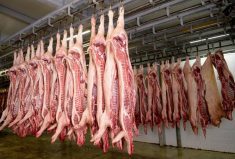The Alberta government will clear a regulatory path for livestock feeder associations to test-run pilot projects looking at different ways to produce and market cattle and to finance that process.
Agriculture Minister Jack Hayden last week announced changes to the provincially-operated Feeder Associations Loan Guarantee Program to allow a pilot project for a feeder association to get a loan guarantee to extend funding through the supply chain.
An amendment to the existing Feeder Associations Guarantee Regulation is meant to emphasize the need for “innovative research and development projects as a way to explore different methods of growing, finishing and marketing cattle,” the province said.
Read Also

U.S. livestock: Cattle futures surge as second screwworm case announced
Chicago | Reuters – Chicago Mercantile Exchange cattle futures rallied on Friday as two new screwworm cases were announced in…
The amendment will also allow any Alberta feeder association to adopt such a program, and to propose other projects in the future, which will be reviewed on a case-by-case basis.
Currently, 53 local co-operative associations in Alberta buy livestock for their members to feed. The province provides a residual loan guarantee to lenders for each feeder association, and also inspects and audits the local associations.
Feeder members can finance 100 per cent of the cost of livestock by depositing five per cent of the value of livestock into a pooled security account held by the local feeder association. In 2008-09, feeder associations bought $220 million worth of livestock for members.
The province on Thursday announced two pilot projects under the amended process: a Supply Chain Financing Pilot Project and an Equity Loan Pilot Project.
Under the Equity Loan Pilot Project, participating feeder associations’ members will be able to access their increased equity on a monthly basis. Currently, feeder members get their increased equity only when livestock is sold and an entire loan is paid off, including interest and other costs.
And in the Supply Chain Financing Pilot Project, protocols will be developed and tested for a program that extends financing under the loan guarantee all the way through the supply chain until the product reaches retail.
Under the current feeder association program structure, capital is provided only up until the sale of the animal, not offered for meat processing or meat marketing.
The government said its amendment was proposed because producers who retain ownership of livestock through the supply chain to market meat products at the wholesale or retail levels often require financing for slaughter/processing costs, along with the feeder cattle financing.
The proposed pilot projects will be similar to the existing feeder association model, but will extend funding through to the meat products being sold to the retailer.
The capital will be in the form of a revolving operating loan, rather than a long-term loan.
“Extending the financial support to the entire supply chain process is going to give producers the added flexibility they need to succeed in their business,” Feeder Associations of Alberta chairman Jim Bowhay said in the province’s release.
“By helping individual producers participate in supply chains, we believe this new project will open the door to develop and grow beef supply chains, making Alberta’s beef industry more sustainable.”
“Producers consistently tell me that they want to be part of the entire supply chain in order to be more profitable,” Hayden said Thursday. “I am committed to any project that will allow for local producers to profit from pasture to plate.”














